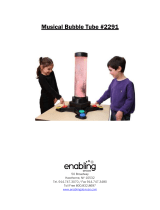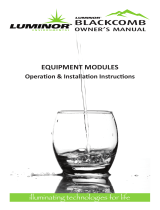Page is loading ...

The Eye Talk base has suction cups for securing to smooth surfaces, in addition there are two
cutouts for C-Clamp use if needed. To use insert the adjustable legs of the Eye-Talk into the
channel’s on each side of the base.
For Technical Support:
Call our Technical Service Department
Monday through Friday, 9 a.m. to 5 p.m. (EST)
1-800-832-8697
IEP Activities for the Eye-Talk
#3700, 3701, 3702, 3712, 4701,
4702, 4703
USER’S GUIDE
50 Broadway
Hawthorne, NY 10532
Tel. 914.747.3070 / Fax 914.747.3480
Toll Free 800.832.8697
www.enablingdevices.com

Now with sturdy base!
Our popular eye gaze communication board is an inexpensive yet effective method of
communicating. Place desired choices on the Eye Talk board and the observer views the eye
gaze of the user and sees their selection. You can create limitless choices for the user to select
using their eyes. The Eye Talks are made of clear, shatter-resistant plastic and comes with two
self-contained height adjustable triangle stands. Included with each Eye Talk is a sturdy base to
hold the triangle stands in place. Order the 4 pack or 10 pack and get one free base or
purchase additional bases separately. Packs also comes with a self-adhesive, clear picture
holding strip (12"L) which can be cut to any length. Size: 17"L x 11½"W x 1/16"H. Weight: ½ lb.
• LTG: To improve ocular motor control for greater success in reading
STO: To demonstrate visual tracking, child will maintain visual contact for 5 seconds on a
visual stimulus out of times.
• Sensory: LTG: To improve ability to use sensory information to understand and effectively
interact with people and objects.
STO: Student will demonstrate the ability to observe and remember information/location:
criteria: method.
*Sample goals were taken from Version 4Curriculum Copyright 1986-1993. Dr. Thomas Reap
and OT Goals by Partners in Goals.
All IEP Activities were developed by Elizabeth Meyer, a pediatric rehabilitation professional
Please note: Peel away the protective film covering from the Eye-Talk, otherwise the adhesive
picture holder strips will not stick.
IEP Activities for the Eye-Talk
Training Activity #1: “See it- Spell it”
Level: difficult
Ages: 12 and up
Diagnoses: cerebral palsy with disarthric speech, spinal cord injury, stroke and ALS
How to proceed: This activity helps to train accurate eye-gaze skills for the more advanced
communicator. Show the child two pictures with the spelling of the words included. For
example, “milk” and “juice”. Instruct child to choose one of the picture/word cards and to spell
it with her/his eyes. The object of the game is for the partner seated on the opposite side of the
user to guess which word was chosen by the ability to follow the user’s gaze as it spells out the
word. The user must first look at the numbered section and then center opening. Then within
the section, gaze at the desired letter. When the word is spelled out, the user is instructed to
maintain gaze at the desired letter. When the word is spelled out, the user is instructed to
maintain gaze in center for 5 seconds or more to indicate completion. Arrange letters as
follows:
Activity Analysis #1: Skills and Performance Components this toy and activity will address:
• Cognitive- follow 2 step directions, visual memory, visual recognition, focus and attention
• Motor- ocular-motor pursuits and saccades
• Sensory- visual and visual perception
• Language- communication skills
Activity IEP* Goals: LTG- Long-Term Goal, STO-Short Term objective (please note this is not an
exhaustive list)
Language- LTG: Student will develop and demonstrate an improvement in alternative means of
communication.
STO: Student will use an eye-gaze communication board to facilitate communication by looking
at individual letters to spell a word in order to communicate a need, __% of the time, criteria:
method.
Motor- LTG: To improve ocular motor control for greater success in reading.
STO: To demonstrate visual tracking child will maintain visual contact for 5 secs on a visual
stimulus _ out of _ times.
Visual-Perception- LTG: To improve visual-perception needed for reading or communicating
using augmentative communication devices.
STO: Child will demonstrate improved saccadic fixation, by quickly moving eye gaze from one
set of letters to another with __% accuracy, __ out of __ times.
Sensory- LTG: To improve ability to use sensory information to understand and effectively
interact with people and objects.
STO: Student will demonstrate the ability to observe and remember information/location:
criteria: method.
Training Activity #2: “Look and Say”
Level: easy
Ages: 6 and up
Diagnoses: cerebral palsy with disarthric speech, spinal cord injury, stroke and ALS
How to Play: This activity helps to train accurate eye-gaze skills. Affix four pictures to each
corner of the Eye-Talk frame. Have 4 matching objects (or
matching pictures to cue the child). Show one of the pictures or objects in the center opening.
Ask the child to find and then look at the picture on the frame that is the same. Demonstrate
and explain that she/he must keep looking at the picture on the frame for 5 seconds. Then
demonstrate and explain that the user must make a second gaze into the center opening to
show the partner that she/he has completed the task.
Activity Analysis #2: Skills and Performance Components this device and activity will address:
• Cognitive: follow 2 step directions, visual memory, visual recognition, focus and attention
• Motor: ocular-motor pursuits and saccades
• Sensory: visual
• Language: communication skills
Activity #2 IEP Goals: *LTG-Long Term Goal, OBJ-Short Term Objective (please note this is not
an exhaustive list)
• Language- LTG: Student will develop and demonstrate an improvement in alternative
means of communication
• STO: Student will use an eye-gaze communication board to facilitate communication by
looking at a picture or word to make a response or communicate a need,__% of the time,
criteria: method.
Rev 8/4/15
/





